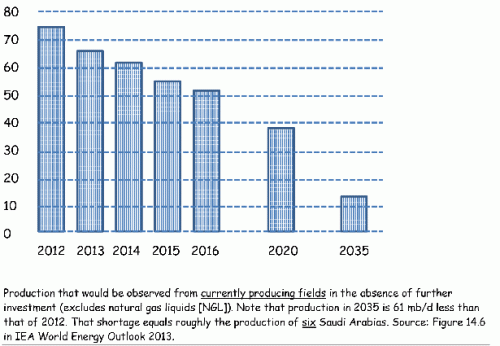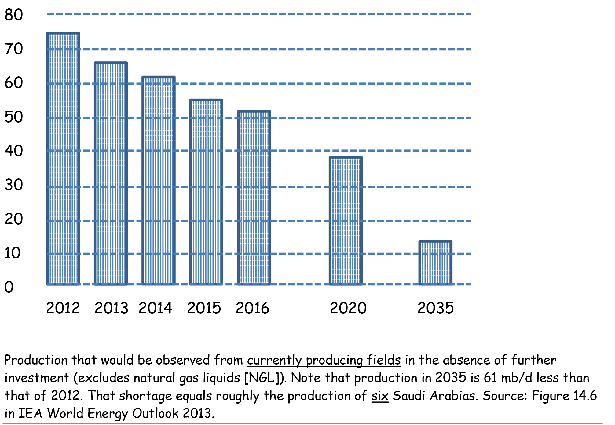
The International Energy Agency released its annual World Energy Outlook on Nov. 12, 2013. Annually each November, the agency provides a status report and offers its forecast of petroleum supplies over the next 20-25 years.
The IEA forecast this year is pessimistic: Here is the chart of production from existing fields, in millions of barrels per day (mb/d):

The chart illustrates that currently producing fields are in decline. The chart projects flow in 2020 from existing fields at 38 mb/day. Crude oil production has been about 74 mb/d. To avoid shortages of oil and gasoline we’ll need new production of 36 mb/d. Finding 36 mb/day appears to be impossible.
The IEA has repeatedly admitted that conventional oil production (vertical wells on land or on continental shelf) is in decline. U.S. light tight oil (LTO), which is fracked in vertical/horizontal wells in shale formations, is predicted to reach 5 or 6 mb/day by 2020 and then decline. That leaves deep ocean drilling, bitumen (tar) sands and arctic wells (now apparently abandoned by Shell Oil Co.). All the additional investments are huge — a fracked well costs $6 million to $9 million today.
The IEA finds a possible 10 million barrels a day in “new” crude oil:
• Iraq 5 mb/d
• Brazil 4 mb/d
• Canada 2.4 mb/d
• Kazakhstan 2 mb/d
• U.S. 1.7 mb/d
Total 15.1 mb/d
Of those, Iraq is in midst of a new civil war, Brazil’s off-shore oil is in unworkable salt formations, Canada’s oil is expensive, destructive and extremely polluting, U.S. oil is shale oil (where the “sweet spots” are predicted to deplete by about 2020) and Kazakhstan is only 2 mb/day. But if they all come through, it is still only 15 mb/day.
By 2020, existing world production totals only 38 mb/day. A very generous (probably unrealistically generous) estimate of new production from new investment is, say 20 mb/day. That is 58 mb/day total in 2020 — 16 mb/day less than today’s total.
That supply shortage would (more likely will) make our world unrecognizable.
The U.S. currently burns 18.6 mb/day; the world uses 75 mb/day, and the U.S. currently produces much less than 10 mb/day. We are not even close to being energy independent.
It appears impossible to offset the decline the IEA envisions: Oil supplies will likely diminish, prices will likely rise and extreme shortages may be the new normal.
The Wall Street Journal reports today (1/30/14) that despite Chevron, Exxon and Shell having jointly spent over half a trillion dollars in the last five years to produce more oil, their production of oil and gas is down.
Every drop of oil we can get our hands on ought to be used to construct renewable energy.
Now. — Tom Giesen